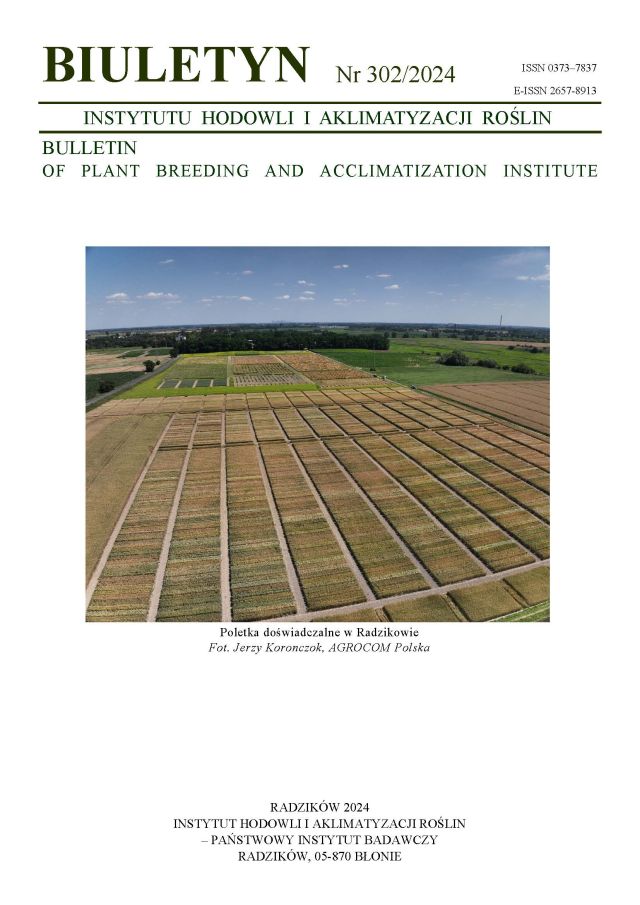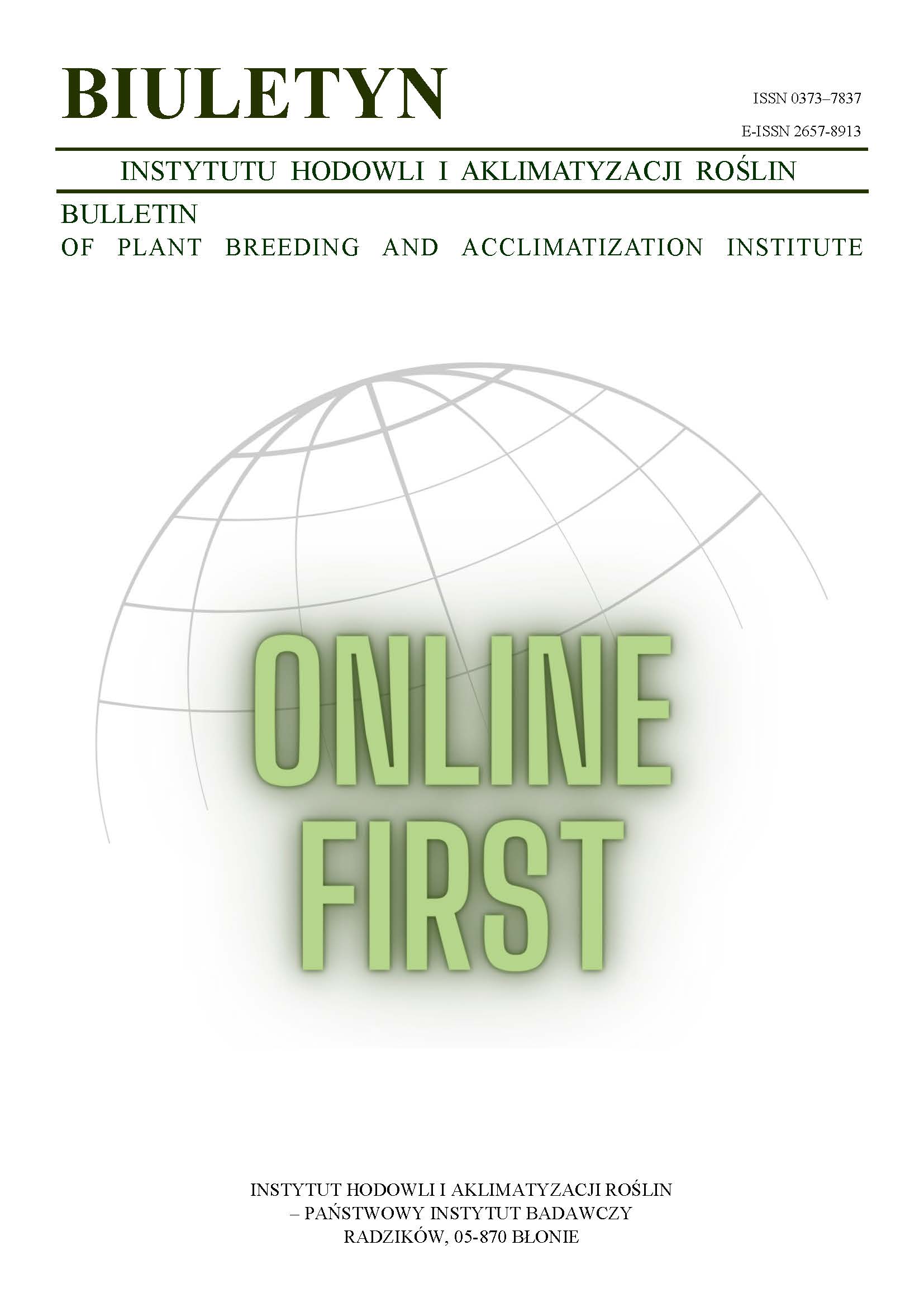The influence of protection against potato late blight on storage durability of tubers of four starch potato cultivars
Barbara Sawicka
dziekanat.agbioinz@up.lublin.plKatedra Szczegółowej Uprawy Roślin, Akademia Rolnicza, Lublin (Poland)
Abstract
Analysis of storage losses of potato tubers was carried out on samples from field experiment performed in 1998–2000 in Parczew. Two experimental factors were studied: cultivation technology (with protection and without protection against potato late blight) and potato cultivars (Karlena, Jantar, Meduza, Panda and mixture of these cultivars). Tuber samples were taken from the field experiment (6 from each combination) and stored in a clamp during 5 months in the 1998/1999–2000/2001 seasons. The samples were placed in two spots at 1/3 and 1/2 distances from the end of clamp and in 3 layers: at the bottom, in the middle, and at the top of the pile. At the end of experiment, the following elements of storage durability were evaluated: germ weight, natural losses of tuber weight due to transpiration and respiration processes and losses due to fungal and bacterial diseases. Technology of cultivation didn’t reduce tuber losses due to germination, respiration, evaporation and rots. Variety properties determined the storage durability. Jantar and mixture of cultivars were very good for long-term storage, while cv. Karlena, Panda and Meduza were good.
Keywords:
cultivars, cultivation technology, storage durability, potatoReferences
Ciećko Z., Wyszkowski M. 1995. Oddziaływanie nawożenia azotem i fungicydów stosowanych w uprawie ziemniaka na ubytki bulw podczas przechowywania. Mat. Konf. Nauk. nt.: „Agrotechnika ziemniaka i wybrane zagadnienia z przechowalnictwa”. Bonin, 9–10 marca: 153 — 157.
Google Scholar
Gąsiorowska B. 2000. Straty przechowalnicze bulw ziemniaka jadalnego i możliwości ich ograniczenia. Rozpr. Nauk, 62, Wyd. Akademia Podlaska, Siedlce: 170 ss.
Google Scholar
Harris R., Kwiatkowski B., Zawadzki J. 1997. Przemieszczanie się propamokarbu w roślinach ziemniaka. Mat. Konf. Nauk. nt.: „Ochrona ziemniaka”. Bonin, 9–10 kwietnia: 18 — 20.
Google Scholar
Hesen J. C. 1981. Storage and quality of potatoes In: 8th Trien. Conf. EAPR München. Survey papers: 123 — 132.
Google Scholar
Kapsa J. 2001. Zaraza (Phytophthora infestans [Mont.] de Bary) występująca na łodygach ziemniaka. Monogr. i Rozpr. Nauk., 11, Wyd. IHAR, Radzików.
Google Scholar
Kapsa J., Osowski J. 1997. Skuteczność zwalczania zarazy ziemniaka z uwzględnieniem aspektów ochrony środowiska i czynników ekologicznych. Mat. Konf. Nauk. nt.: „Ochrona ziemniaka”. Kołobrzeg, 9 — 10 kwietnia: 54 — 59.
Google Scholar
Kuźniewicz-Czerko M., Sowa-Niedziałkowska G. 1992. Trwałość przechowalnicza odmian przydatnych do przetwórstwa. Ziemn. Polski, 3, 21 — 23.
Google Scholar
Sawicka B. 1984. Czynniki warunkujące trwałość przechowalniczą bulw 4 odmian ziemniaka. Biul. Inst. Ziemn. 31: 71 — 82.
Google Scholar
Sawicka B. 1999. Effects of growth regulators, Mival and Poteitin, application in potato cultivation. Part III. The influence of growth regulators on storage losses of tubers. Annals of Agricult. Sci, E-28 (1/2): 67 — 80.
Google Scholar
Sawicka B., Kuś J. 2001. Trwałość przechowalnicza odmian ziemniaka w zależności od systemu produkcji. Zesz. Nauk. AR im. H. Kołłątaja w Krakowie, 76: 153 — 159.
Google Scholar
Schippers P. A. 1977. The rate of respiration of potato tubers during storage. 3. Relationships between rate of respiration weight lose and other variables. Potato Res., 20 (4): 321 — 328.
DOI: https://doi.org/10.1007/BF02362243
Google Scholar
Sowa-Niedziałkowska G. 1994. Sposoby ograniczania strat przechowalniczych. Wyd. Inst. Ziemn., Bonin.
Google Scholar
Sowa-Niedziałkowska G. 1999. Wpływ wybranych czynników na zmiany ilościowe w czasie przechowywania odmian jadalnych. Mat. Konf. Nauk. nt.: „Ziemniak jadalny i dla przetwórstwa spożywczego — czynniki agrotechniczne i przechowalnicze warunkujące jakość”. Radzików, 23–25 lutego: 96 — 98.
Google Scholar
Sowa-Niedziałkowska G. 2003. Charakterystyka trwałości przechowalniczej zrejonizowanych odmian ziemniaka. Mat. Konf. Nauk. nt.: „Znaczenie odmiany w agrotechnice i przechowalnictwie ziemniaka”. Jadwisin, 26–27 marca: 29.
Google Scholar
Sowa G., Kuźniewicz M. 1985. Przyczyny powstawania strat w czasie przechowywania ziemniaków. Biul. Inst. Ziemn. 33: 81 — 95.
Google Scholar
Thalburt W. F., Smith O. 1987. Potato processing. An AVI Published by Van Nostrand Reinhold Company, New York.
Google Scholar
Thalburt W. F., Smith O. 1989. Potato processing. The AVI Publishing Comp. INC., Westport Connection.
Google Scholar
Vereijken P. 1992. A methodical way to more sustainable farming systems. Neth. J. Agric. Sci., 40: 209 — 223.
DOI: https://doi.org/10.18174/njas.v40i3.16507
Google Scholar
Wojdyła T. 1996. Wpływ zastosowanych fungicydów przeciwko Phytophthora infestans i nawożenia azotem na przechowywanie bulw wybranych odmian ziemniaków. Fragm. Agron., 4 (56): 4 — 17.
Google Scholar
Zarzycka H., Sobkowiak S. 1997. Ocena zmian zachodzących w polskiej populacji Phytophthora infestans [Mont.] de Bary. Biul. Inst. Ziemn., 48: 125 — 135.
Google Scholar
Authors
Barbara Sawickadziekanat.agbioinz@up.lublin.pl
Katedra Szczegółowej Uprawy Roślin, Akademia Rolnicza, Lublin Poland
Statistics
Abstract views: 58PDF downloads: 17
License
Copyright (c) 2004 Barbara Sawicka

This work is licensed under a Creative Commons Attribution-ShareAlike 4.0 International License.
Upon submitting the article, the Authors grant the Publisher a non-exclusive and free license to use the article for an indefinite period of time throughout the world in the following fields of use:
- Production and reproduction of copies of the article using a specific technique, including printing and digital technology.
- Placing on the market, lending or renting the original or copies of the article.
- Public performance, exhibition, display, reproduction, broadcasting and re-broadcasting, as well as making the article publicly available in such a way that everyone can access it at a place and time of their choice.
- Including the article in a collective work.
- Uploading an article in electronic form to electronic platforms or otherwise introducing an article in electronic form to the Internet or other network.
- Dissemination of the article in electronic form on the Internet or other network, in collective work as well as independently.
- Making the article available in an electronic version in such a way that everyone can access it at a place and time of their choice, in particular via the Internet.
Authors by sending a request for publication:
- They consent to the publication of the article in the journal,
- They agree to give the publication a DOI (Digital Object Identifier),
- They undertake to comply with the publishing house's code of ethics in accordance with the guidelines of the Committee on Publication Ethics (COPE), (http://ihar.edu.pl/biblioteka_i_wydawnictwa.php),
- They consent to the articles being made available in electronic form under the CC BY-SA 4.0 license, in open access,
- They agree to send article metadata to commercial and non-commercial journal indexing databases.
Most read articles by the same author(s)
- Barbara Sawicka, Władysław Michałek, Piotr Pszczółkowski, Determinants of yield potential of medium-late and late potato cultivars in central-eastern Poland , Bulletin of Plant Breeding and Acclimatization Institute: No. 259 (2011): Regular issue
- Barbara Sawicka, Barbara Krochmal-Marczak, Ecological aspects of potato cultivation in Strzyżowsko-Dynowskie Foothills , Bulletin of Plant Breeding and Acclimatization Institute: No. 259 (2011): Regular issue
- Piotr Barbaś, Barbara Sawicka, The content of vitamin C in potato tubers depending on different methods of potato production , Bulletin of Plant Breeding and Acclimatization Institute: No. 278 (2015): Regular issue
- Barbara Sawicka, Piotr Pszczółkowski, Phenotypic variation of yield structure of potato cultivars under conditions of mid-eastern Poland , Bulletin of Plant Breeding and Acclimatization Institute: No. 232 (2004): Regular issue
- Barbara Sawicka, Piotr Pszczółkowski, Attempts to control infestation of potato canopy cultivated under shields , Bulletin of Plant Breeding and Acclimatization Institute: No. 228 (2003): Regular issue














